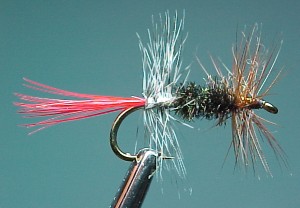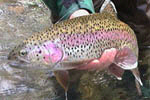Fly Tied By:
Thomas C. Duncan, Sr.
Fly Developed
By: Myrtle Powell
Story By: Thomas C.
Duncan, Sr.
Home: Fieldbrook,
California
E-mail: pastortd@tidepool.com
Web site: www.tidepool.com/~pastortd |
Thomas has been
fly fishing since a young boy in the Sierras. A commercial fly tier, Thomas has won two fly
tying awards, which are featured on his Web site. He
enjoys building rods and teaching
tying, casting, and fishing skills to young people in his
community. He is Pastor of Fieldbrook Community Church on the
North Coast of California, where he lives with his wife and
two boys. |
How
many fly patterns are there? Well, the question has been asked many
times, but the answer is always the same; the number of patterns is innumerable.
Further, the number of patterns and variations on patterns yet to be
developed is limited only by the imagination of the tiers creating
them.
The early twentieth century saw a
boom in the development of fly patterns by tiers in the Western
states as the general population as well as the popularity of
fly-fishing grew. My grandfather went west to be a part of the
agricultural action, but soon found himself in the middle of the
fly-fishing action as well. No matter how many new flies were cast
across the Yuba, Feather, and Sacramento Rivers of Northern CA,
though, Granddad stuck to one fly, and one fly only - Myrtle
Powell's Buzz Hackle.
At the time, the legendary cane
rod maker E. C. Powell was running his shop from Marysville, CA.
Granddad got his rods from Mr. Powell; 5- and 6-weight rods around 8
feet in length. Complex tapers with hollow construction and stout
butt sections, these would handle any situation the wild west would
offer. I guess Granddad figured a fly should be just as versatile,
because he got his flies from the same shop.
Mrs. Powell was a fly-tier of
note, and put out quite a number of flies from the Marysville store
for local fishers. In the 1920's she was asked to tie an all-around
attractor fly by one Al Lent, a friend of the family who was tired
of being outfished by friends as frequently as he was. His
instructions were that the fly should be tied using the most
attractive materials: tinsel, grizzly and brown hackle, and the
ever-important Peacock herl. As the story has it, the ensuing fly
was used to make quite the fisherman of the frustrated customer.
When Mr. Lent's son, nicknamed "Buzz" died a few years later, he
requested that it be renamed in his honour. Hence, it became known
as the Buzz Hackle.
Granddad loved that fly. Grandma
might go streamside and turn over rocks, leaves, and debris to study
what was hatching on any particular day, but Granddad huffed away
such action, stubbornly insisting, "Just tie on a Buzz Hackle!" In
his book, this was the only fly that existed, and he would proceed
to catch fish on it! The only variation he would fish was a
Reverse Buzz Hackle, which had the brown hackle in the back
and the grizzly up front. If they wouldn't take a Buzz Hackle, he
figured, they will definitely take a Reverse Buzz because Trout know
the difference! With all due respect to my late Granddad, I'm still
not sure about that one!
When I began tying as a child,
Granddad was already pretty old, and not fishing any longer. He took
an interest immediately, though, and made sure I was on the right
track. Years later, I still remember the conversation between us as
I sat on the couch, and he in his favourite reclining chair. Mom
prompted me over to tell him of my recent accomplishment, and I
began the dialogue:
"Granddad, I started tying
flies."
"Is that so? Did your dad give you materials?"
"Uh-huh - I'm using his."
At this point, Granddad leans
closer on the arm of his chair, and looks intently at me.
"Did he show you how to tie a Buzz Hackle?"
"Uh-huh."
"Good deal!"
Granddad slaps his hand favourably on the
chair and settles back, smiling. I guess he figures I know all I
need to know about tying and flies!
A lot of time has passed since
then, and the Buzz Hackle is not as widely used as it might have
been even thirty years ago. A remnant of fly fishers in the northern
Sacramento valley still make good use of the fly, and although I no
longer live there, I still carry it with me, and fish it frequently.
It has caught all species of Trout, Panfish, Bass, and even
Steelhead for me, and I'm sure it will continue to do so as long as
I can fish for them.
I have made a few alterations in
tying the fly, however. Generally I will use bucktail dyed red for
the tail as it is more durable and buoyant than the traditional
hackle fibres. I also wind a single strand of Krystal Flash in place
of the tinsel, as the thinner material is easier to work with, and
puts less bulk on the finished fly. You might also notice that on
the pictured fly, the fore hackle is slightly smaller than the aft
hackle. This keeps the hook bend from dragging the tail and rear of
the fly into the water and floating along at a diagonal. The slight
downward and forward slant allows the fly to float more evenly,
counteracting the weight of the bend. Many variations exist -- it is
not unheard of to tie this fly on a wet fly hook and use hen hackles
for a sleek, attractive subsurface fly!
Give the fly a try - you may be
like me, and keep a few in different sizes in your box at all times.
Beware, though. You may be like my Granddad, and never fish another
fly again!
--Thomas C. Duncan,
Sr.

Hook: Dry fly, sizes 10 to
16
Thread: Black, 6/0
Tail:
Red hackle fibers
Aft Hackle: Grizzly
over silver tinsel
Body: Peacock
herl
Fore Hackle: Brown over gold
tinsel |
|



